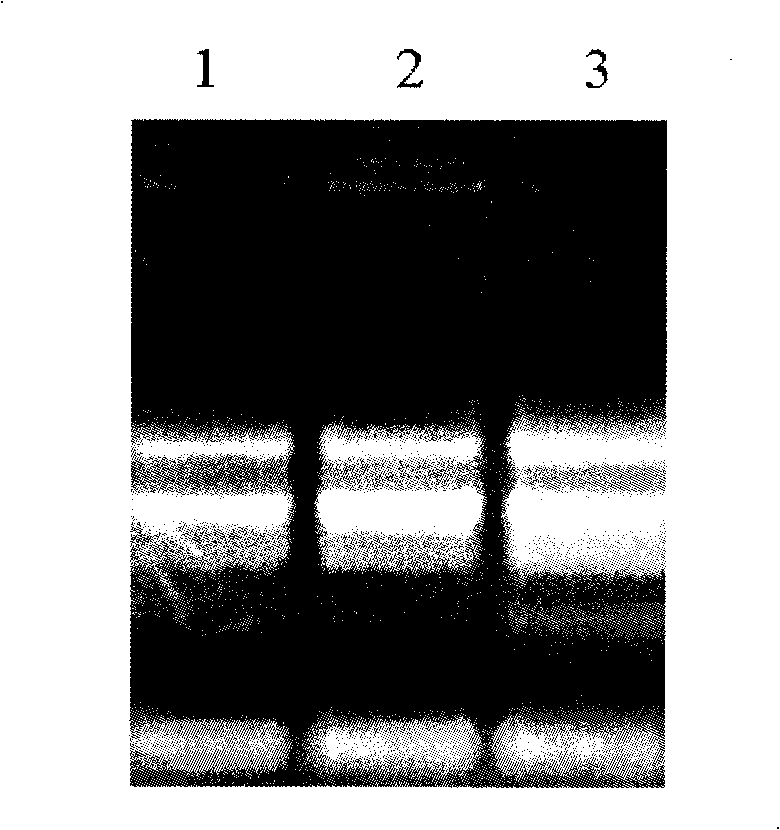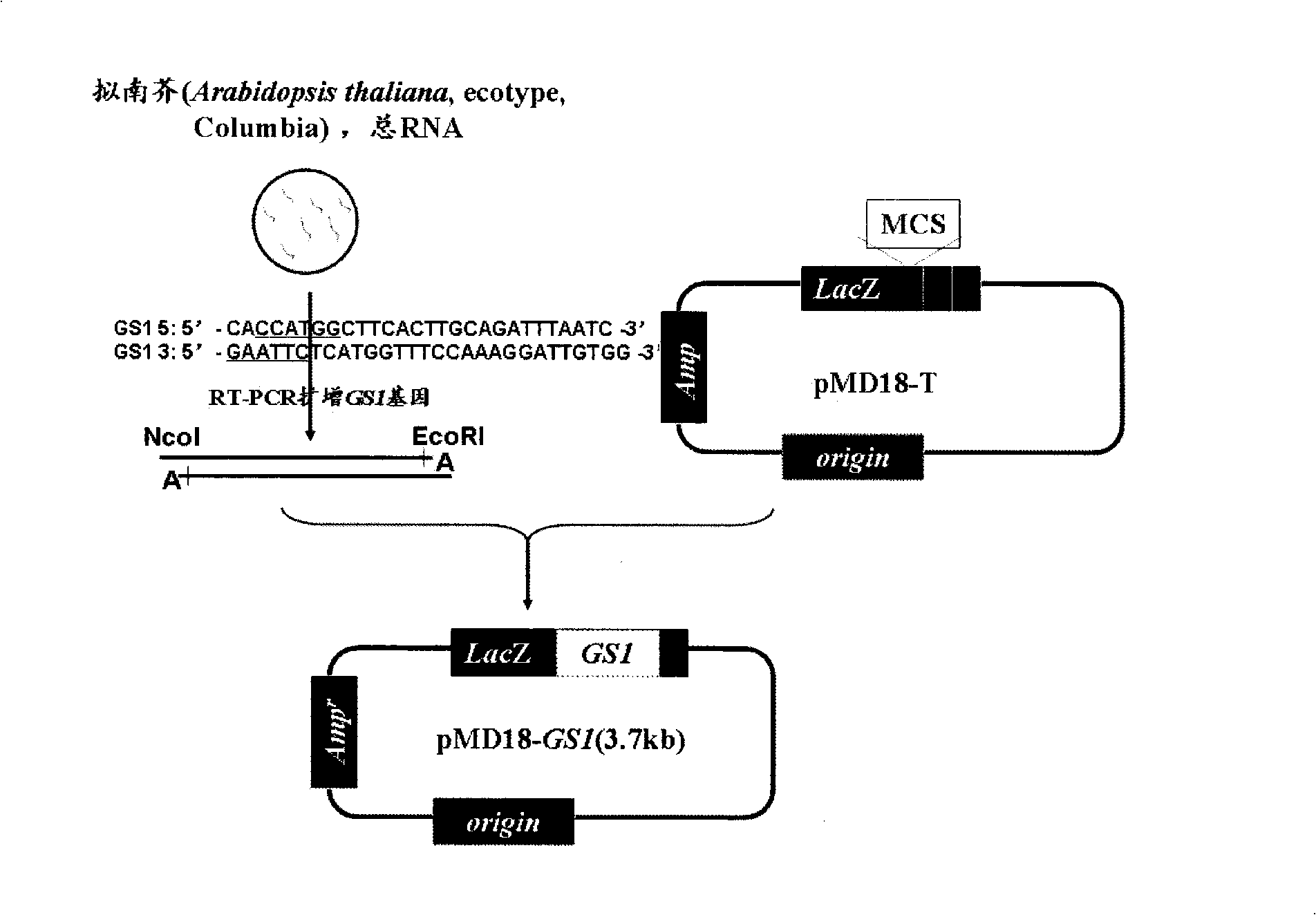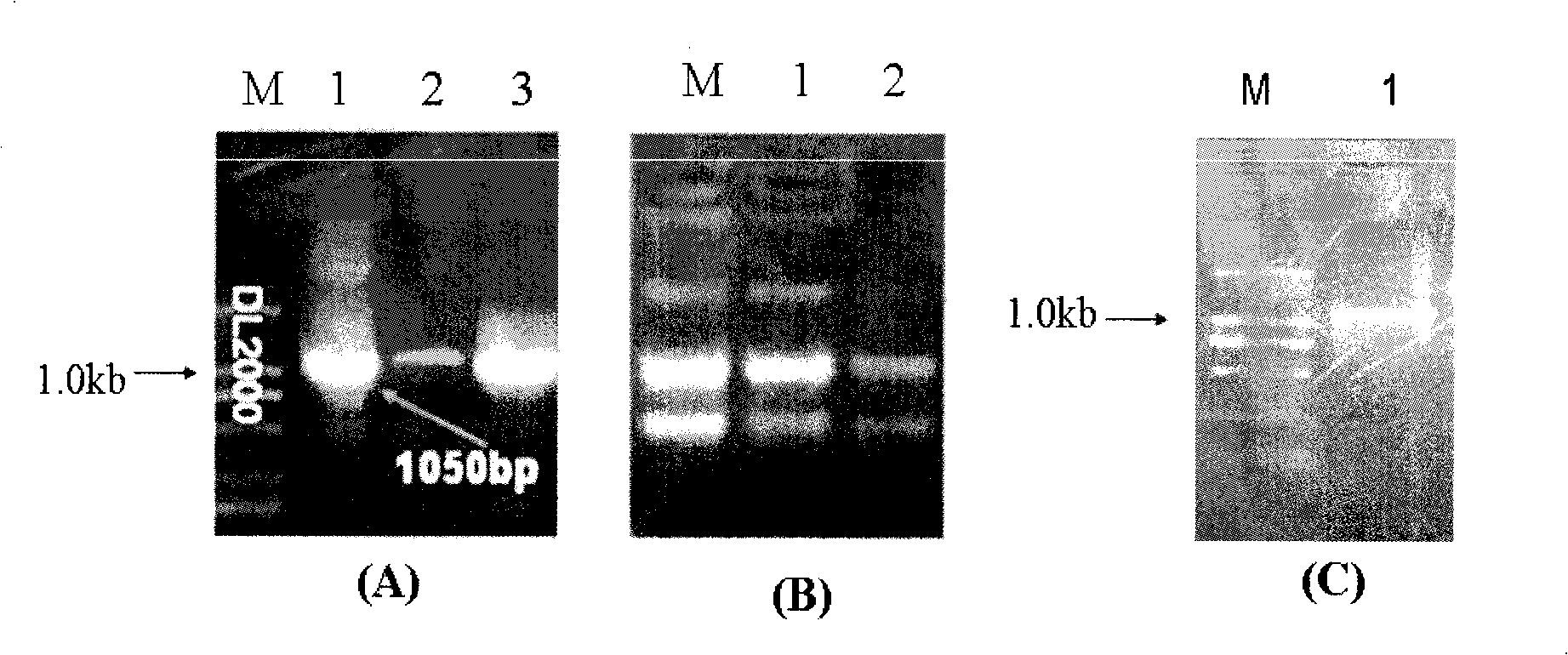Construction and use of plant expression vector of Arabidopsis thaliana cytoplasm type glutamine synthetase gene
A plant expression vector, glutamine technology, applied in the field of plant genetic engineering
- Summary
- Abstract
- Description
- Claims
- Application Information
AI Technical Summary
Problems solved by technology
Method used
Image
Examples
Embodiment 1
[0051] Example 1: Extraction and detection of Arabidopsis total RNA
[0052] In the present invention, Arabidopsis thaliana (Arabidopsis thaliana, ecotype, Columbia) total RNA was prepared using the TRNzol Reagent (purchased from invitrogen company) method. Take 0.1g of fresh leaf tissue, quickly and fully grind it into powder in liquid nitrogen, add 1ml of TRIzoL RNA extraction solution, mix well, let stand at room temperature for 5min, add 0.2ml of chloroform, shake vigorously and mix well, centrifuge at 12000rpm at 4°C for 15min , transfer the upper aqueous phase to a new tube, add an equal volume of isopropanol, mix well and place at room temperature for 10 min. Centrifuge at 12000rpm for 10min at 4°C, discard the supernatant, wash the pellet once with 1ml of 75% ethanol, dry the pellet in vacuum, add 20μl of diethylpyrocarbonate (DEPC) treated water to fully dissolve the RNA, take 2μl of total RNA and wash with 1.2% agar Glucose gel electrophoresis detection, the results...
Embodiment 2
[0053] Example 2: Amplification and TA cloning of GS1 gene
[0054] GS1 gene amplification and TA cloning strategies such as figure 2 As shown, first search the full-length cDNA sequence of Arabidopsis thaliana cytoplasmic GS1 coding region from GenBank, and design a pair of primers with the following sequence:
[0055] GS 15: 5'-CA CCATGG CTTCACTTGCAGATTTAATC-3'
[0056] GS 13: 5'- GAATTC TCATGGTTTCCAAAGGATTGTGG-3'
[0057] Primer GS15 at the 5' end adds the CACC characteristic sequence to the 5' end, and thus generates an NcoI restriction site; primer GS13 at the 3' end adds an EcoRI site restriction end.
[0058] Using Arabidopsis total RNA as a template, using RevertAid TM - MuLV Reverse Transcriptase Kit (Fermentas) for cDNA synthesis. Take 0.1-0.5μg of total plant RNA, 50ng of oligo(dT), 1μl of 10mM dNTP mix, make up to 10μl with DEPC-treated water, mix well, then centrifuge briefly to collect it at the bottom of the tube, and place it in a constant temperature d...
Embodiment 3
[0060] Example 3: Construction of Gateway entry cloning vector pENTR*-PrbcS-GS1
[0061] The construction strategy of pENTR*-PrbcS-GS1 is as follows Figure 4 As shown, the purified plasmid vectors pENTR*-PrbcS-*T-GFP (patent application number is 200710066422.9) and pMD18-GS1 were cut with NcoI (Fermentas) and EcoRI (Fermentas), and separated by agarose gel electrophoresis. The vector and insert fragments, the vector fragment pENTR*-PrbcS (3.8kb) produced after pENTR*-PrbcS-*T-GFP was cleaved and the GS1 gene produced by cleavage of pMD18-GS1 were recovered from the gel The DNA fragment (1.0kb), and then use the ligase kit of TaKaRa to connect the DNA fragment of pENTR*-PrbcS and GS1 gene to generate the entry vector pENTR*-PrbcS-GS1. Use the ligation reaction mixture to transform high-efficiency (108) Escherichia coli competent (DH5α, Tiangen Biochemical Technology), and spread the transformed Escherichia coli on an LB plate added with kanamycin (Km, 50 μg / ml), Cultivate o...
PUM
 Login to View More
Login to View More Abstract
Description
Claims
Application Information
 Login to View More
Login to View More - R&D
- Intellectual Property
- Life Sciences
- Materials
- Tech Scout
- Unparalleled Data Quality
- Higher Quality Content
- 60% Fewer Hallucinations
Browse by: Latest US Patents, China's latest patents, Technical Efficacy Thesaurus, Application Domain, Technology Topic, Popular Technical Reports.
© 2025 PatSnap. All rights reserved.Legal|Privacy policy|Modern Slavery Act Transparency Statement|Sitemap|About US| Contact US: help@patsnap.com



